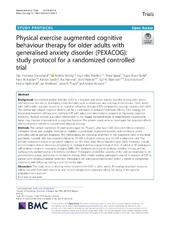| dc.contributor.author | Stavestrand, Silje Haukenes | |
| dc.contributor.author | Sirevåg, Kristine | |
| dc.contributor.author | Nordhus, Inger Hilde | |
| dc.contributor.author | Sjøbø, Trond | |
| dc.contributor.author | Endal, Trygve | |
| dc.contributor.author | Nordahl, Hans Morten | |
| dc.contributor.author | Specht, Karsten | |
| dc.contributor.author | Hammar, Åsa | |
| dc.contributor.author | Halmøy, Anne | |
| dc.contributor.author | Martinsen, Egil Wilhelm | |
| dc.contributor.author | Andersson, Eva | |
| dc.contributor.author | Hjelmervik, Helene | |
| dc.contributor.author | Mohlman, Jan | |
| dc.contributor.author | Thayer, Julian Francis | |
| dc.contributor.author | Hovland, Anders | |
| dc.date.accessioned | 2019-11-12T15:46:52Z | |
| dc.date.available | 2019-11-12T15:46:52Z | |
| dc.date.issued | 2019-03-18 | |
| dc.Published | Stavestrand S.H., Sirevåg K, Nordhus IH, Sjøbø T, Endal T, Nordahl HM, Specht K, Hammar Å, Halmøy A, Martinsen EW, Andersson E, Hjelmervik HS, Mohlman J, Thayer JF, Hovland A. Physical exercise augmented cognitive behaviour therapy for older adults with generalised anxiety disorder (PEXACOG): Study protocol for a randomized controlled trial. Trials. 2019;20 : 174(1):1-14 | eng |
| dc.identifier.uri | https://hdl.handle.net/1956/20993 | |
| dc.description.abstract | Background Generalised anxiety disorder (GAD) is a frequent and severe anxiety disorder among older adults. GAD increases the risk of developing other disorders such as depression and coronary heart disease. Older adults with GAD exhibit a poorer response to cognitive behaviour therapy (CBT) compared to younger patients with GAD. The normal age-related cognitive decline can be a contributor to reduced treatment efficacy. One strategy for improving treatment efficacy is to combine CBT with adjunctive interventions targeted at improving cognitive functions. Physical exercise is a viable intervention in this regard. Increased levels of brain-derived neurotrophic factor may mediate improvement in cognitive function. The present study aims to investigate the proposed effects and mechanisms related to concomitant physical exercise. Methods The sample comprises 70 participants aged 60–75 years, who have GAD. Exclusion criteria comprise substance abuse and unstable medication; inability to participate in physical exercise; and conditions which precludes GAD as primary diagnosis. The interventions are individual treatment in the outpatient clinic at the local psychiatric hospital, with two experimental arms: (1) CBT + physical exercise and (2) CBT + telephone calls. The primary outcome measure is symptom reduction on the Penn State Worry Questionnaire. Other measures include questionnaires, clinical interviews, physiological, biological and neuropsychological tests. A subset of 40 participants will undergo magnetic resonance imaging (MRI). After inclusion, participants undergo baseline testing, and are subsequently randomized to a treatment condition. Participants attend five sessions of the add-on treatment in the pre-treatment phase, and move on to interim testing. After interim testing, participants attend 10 sessions of CBT in parallel with continued add-on treatment. Participants are tested post-intervention within 2 weeks of completing treatment, with follow-up testing 6 and 12 months later. Discussion This study aims to develop better treatment for GAD in older adults. Enhancing treatment response will be valuable from both individual and societal perspectives, especially taking the aging of the general population into account. | en_US |
| dc.language.iso | eng | eng |
| dc.publisher | BioMed Central | eng |
| dc.rights | Attribution CC BY | eng |
| dc.rights.uri | http://creativecommons.org/licenses/by/4.0/ | eng |
| dc.subject | Generalised anxiety disorder | eng |
| dc.subject | GAD | eng |
| dc.subject | Older adults | eng |
| dc.subject | Physical exercise | eng |
| dc.subject | Cognitive behavioural therapy | eng |
| dc.subject | CBT | eng |
| dc.subject | RCT | eng |
| dc.subject | Brain-derived neurotrophic factor | eng |
| dc.subject | Executive function | eng |
| dc.title | Physical exercise augmented cognitive behaviour therapy for older adults with generalised anxiety disorder (PEXACOG): Study protocol for a randomized controlled trial | eng |
| dc.type | Peer reviewed | |
| dc.type | Journal article | |
| dc.date.updated | 2019-09-26T07:23:38Z | |
| dc.description.version | publishedVersion | |
| dc.rights.holder | Copyright The Author(s) 2019 | eng |
| dc.identifier.doi | https://doi.org/10.1186/s13063-019-3268-9 | |
| dc.identifier.cristin | 1702784 | |
| dc.source.journal | Trials | |

